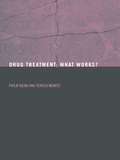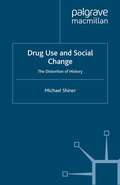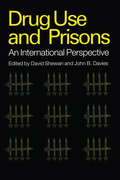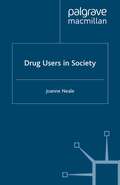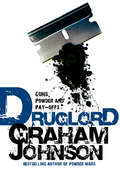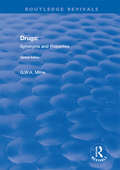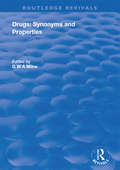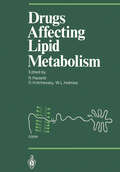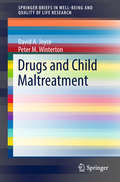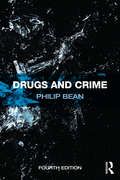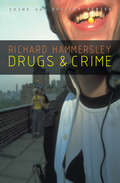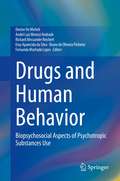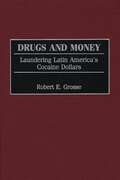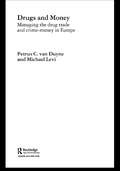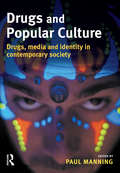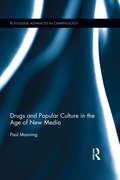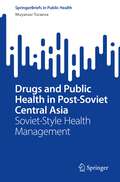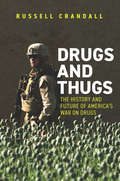- Table View
- List View
Drug Treatment: What Works?
by Philip Bean Teresa NemitzBritain, like almost everywhere else, has a burgeoning drug problem. Finding ways of dealing with this problem is a major platform of government policy and a great deal has been made of the impact of treatment on drug users. Drug Treatment: What Works? is a cutting edge survey of the latest developments in these treatments, and it sets out to ask some of the crucial questions in the treatment of drug abusers; including:* Which treatments work with what sorts of abusers?* What are the key indicators of likely success?* Does coercion work or must treatment be freely entered into? * Is drug testing an essential backup for successful treatment?Featuring contributions from some the leading figures in this field, Drug Treatment: What Works? will be essential reading for students, academics and professionals studying drug treatment in the areas criminology, social policy and medicine.
Drug Use and Social Change: The Distortion of History
by M. ShinerThis book locates the rise of illicit drug use within the historical development of late industrial society and challenges the prevailing view. Highlighting key areas of continuity and the on-going value of classic criminological theory, it is argued that recent trends do not constitute the radical departure that is often supposed.
Drug Use in Prisons
by ShewanFirst Published in 2000. Routledge is an imprint of Taylor & Francis, an informa company.
Drug Use in Prisons (Scottish Prison Service Occasional Paper Ser.)
by ShewanFirst Published in 2000. Routledge is an imprint of Taylor & Francis, an informa company.
Drug Users in Society
by Joanne NealeThis book provides a candid insight into the lives of individuals who are addicted to heroin and other opiates. The processes of obtaining and using drugs are explored within the wider context of personal biographies and daily routines. Key issues considered include childhood experiences, crime and violence, housing situations, family relationships, prison life, health matters and drug treatments. Drug users' statements are related to policy, service provision, previous research, and theoretical debates in the hope that this might increase understanding and improve future responses to drug problems.
Druglord: Guns, Powder and Pay-Offs
by Graham JohnsonWhen ruthless drug baron John Haase was sentenced to 18 years' imprisonment for heroin-trafficking in 1995, it was a major victory for Customs and the police. But in a shock move, after Haase and his partner Paul Bennett had served only 11 months, then Home Secretary Michael Howard signed a Royal Pardon for their release. Howard defended his decision by revealing that Haase and Bennett had become invaluable informants. But Haase had in fact duped the authorities, and far from being forced into hiding as a supergrass, he gained new kudos among the criminal underworld for beating the system so audaciously. Graham Johnson interviewed Haase at Whitemoor prison and has obtained a copy of his sworn affidavit revealing the truth behind the Royal Pardon scandal. Allegations of huge bribes, mass fabrication of evidence and dark powers at the heart of the justice system make this an explosive exposé of Britain's number-one drug kingpin.
Drugs: Synonyms and Properties (Routledge Revivals)
by G W MilneThis title was first published in 2002: Drugs: Synonyms and Properties provides comprehensive coverage of the 10,000 drugs currently in common use worldwide. Its overall organization and inclusion of detailed chemical information fills an important gap in drug information. This reference, edited by a world–renowned authority in drug design and chemical information and now in its second edition, has become one of the bibles of pharmaceutical research and application. This book organizes the 10,000 drugs currently in use by therapeutic category. Therefore all tranquilizers, all antidepressants, or all anorexic agents, for example, are grouped together. In all, 204 categories are represented. This arrangement means that all drugs in a given category can be reviewed very easily and their relative properties compared quickly. A key component of this reference is the extensive coverage of synonyms. The book includes an index of over 30,000 drug synonyms and trade names with a cross–reference to their main entry. This extraordinarily comprehensive view of trade names and generic synonyms makes Drugs: Synonyms and Properties one of the world′s most exhaustive references in its field. For each main entry, the following information is provided: chemical name and a list of trade names and synonyms; the Chemical Abstracts Service (CAS) Registry Number; the European Inventory of Existing Commercial Chemical Substances (EINECS) Number; the Merck Index (Twelfth Edition) Number; the physical properties of each compound; and the known biological activity and indicated applications. Indexes, including a master index of names and synonyms, and of manufacturers and suppliers, are appended. This reference will be invaluable to research chemists, biologists, and physicians and to anyone interested in drugs who, starting with a single synonym for a drug, will be able to quickly find a thumbnail sketch of the essential information concerning that agent.
Drugs: Synonyms and Properties (Routledge Revivals)
by G W MilneThis title was first published in 2002: Drugs: Synonyms and Properties provides comprehensive coverage of the 10,000 drugs currently in common use worldwide. Its overall organization and inclusion of detailed chemical information fills an important gap in drug information. This reference, edited by a world–renowned authority in drug design and chemical information and now in its second edition, has become one of the bibles of pharmaceutical research and application. This book organizes the 10,000 drugs currently in use by therapeutic category. Therefore all tranquilizers, all antidepressants, or all anorexic agents, for example, are grouped together. In all, 204 categories are represented. This arrangement means that all drugs in a given category can be reviewed very easily and their relative properties compared quickly. A key component of this reference is the extensive coverage of synonyms. The book includes an index of over 30,000 drug synonyms and trade names with a cross–reference to their main entry. This extraordinarily comprehensive view of trade names and generic synonyms makes Drugs: Synonyms and Properties one of the world′s most exhaustive references in its field. For each main entry, the following information is provided: chemical name and a list of trade names and synonyms; the Chemical Abstracts Service (CAS) Registry Number; the European Inventory of Existing Commercial Chemical Substances (EINECS) Number; the Merck Index (Twelfth Edition) Number; the physical properties of each compound; and the known biological activity and indicated applications. Indexes, including a master index of names and synonyms, and of manufacturers and suppliers, are appended. This reference will be invaluable to research chemists, biologists, and physicians and to anyone interested in drugs who, starting with a single synonym for a drug, will be able to quickly find a thumbnail sketch of the essential information concerning that agent.
Drugs: Synonyms and Properties (Routledge Revivals)
by G W A MilneThis title was first published in 2000: Drugs play an important role throughout the world. In industrialized countries where a formal approval process governs the introduction of new medicinal agents, thousands of chemicals are in use as drugs. This book provides a detailed picture of this marketplace. Grouped by their medicinal use and biological activity, 8,000 drugs in common use around the world are described. For each, the chemical name and a list of trade names and synonyms are provided; the CAS Registry Number and the European Inventory of Existing Chemical Substances (EINECS) Number are given; the physical properties of each compound are described, and the known biological activity and indicated applications are presented. Indexes, including a master index of name and synonyms, are appended. This compendium should be valuable to physicians, research chemists, biologists and the lay public who, with a single synonym for a drug, will be able to quickly find a thumbnail sketch of the essential information concerning the agent
Drugs: Synonyms and Properties (Routledge Revivals)
by George W. A. MilneThis title was first published in 2000: Drugs play an important role throughout the world. In industrialized countries where a formal approval process governs the introduction of new medicinal agents, thousands of chemicals are in use as drugs. This book provides a detailed picture of this marketplace. Grouped by their medicinal use and biological activity, 8,000 drugs in common use around the world are described. For each, the chemical name and a list of trade names and synonyms are provided; the CAS Registry Number and the European Inventory of Existing Chemical Substances (EINECS) Number are given; the physical properties of each compound are described, and the known biological activity and indicated applications are presented. Indexes, including a master index of name and synonyms, are appended. This compendium should be valuable to physicians, research chemists, biologists and the lay public who, with a single synonym for a drug, will be able to quickly find a thumbnail sketch of the essential information concerning the agent
Drugs Affecting Lipid Metabolism (Proceedings in Life Sciences)
by Rodolfo Paoletti David Kritchevsky William L. HolmesThe recent symposium and the appearance of this new book on Drugs Affecting Lipid Metabolism take place at a very unusual time for the development of this area. After the publication and wide acceptance of the results of the cholestyramine study by the Lipid Clinics in the USA, showing for the first time a direct association between drug induced reduction of plasma levels of total and LDL cholesterol and coronary heart disease in a high risk population, an unparalleled interest in drugs and other procedures able to control plasma cholesterol levels has been activated. Two other significant events occurred during 1986 and 1987: the availability of compact instruments for the immediate determination of total cholesterol in plasma or total blood and the developments of new agents such as the inhibitors of HMG-CoA (hydroxymethyl glutaryl CoA) reductase and ACAT inhibitors, with potentially great effect on plasma lipid levels after oral administration. These new advances, together with the combined efforts of cell biologists and lipoprotein chemists, have set the pace for an exciting period of research and clinical applications of diets and drugs af fecting lipids. This volume, which includes the work of many of the leading world laboratories, represents an authoritative and up-to-date ap praisal of the status of the art and a stimulus to future research at laboratory and clinical level in an area of opportunity for clinical and preventive medicine.
Drugs and Child Maltreatment (SpringerBriefs in Well-Being and Quality of Life Research)
by David A. Joyce Peter M. WintertonThis book combines experience in child protection with expertise in clinical pharmacology and forensic toxicology, to set out a broad contemporary understanding of child maltreatment with drugs. It explores presentations that range through ante-natal exposure, factitious illness, deliberate poisoning, drug accidents while in the care of drug-affected adults, misuse of therapeutic drugs and the drug-related death of a child. It describes how to recognise where deliberate drug exposure or perversion of proper therapeutics is being used to harm a child, how to use laboratory testing to confirm a diagnosis, how to combine medical and social care with the need to gather legal evidence and how to deploy social, medical and legal resources for child protection. The roles of the forensic toxicologist and contemporary forensic laboratory methods in resolving cryptic presentations are discussed in each context. There is guidance on effective communication about drugs within the child protection team and on writing reports for legal purposes, on the way to returning the child to safety. The book also explores the particular difficulties that arise in reconciling parents' rights and cultural beliefs with the obligation to document a child’s drug exposure and in dealing with parents and carers who themselves may be drug-impaired.
Drugs and Crime
by Philip BeanA high proportion of crimes committed in Britain are drugs-related, with many offenders having a documented history of drug use. However, the direct link between drugs and crime is often less clear than is supposed and this text attempts to achieve a better understanding of these and surrounding issues that have been marred by misunderstanding and a lack of consensus amongst experts. This text offers a major contribution to existing debates and provides an authoritative and much-needed overview of the range of issues associated with drugs-related crime. Coverage includes: a discussion on theoretical approaches to drugs and crime, an overview of the legal position on drugs and drug offenders, a critique of the aims and nature of treatment, an examination of trafficking and laundering, an analysis of the policing of drugs markets, a discussion about the legalisation debates. This new edition has been fully updated to include the latest data and recent developments in policy and particular attention is paid to changes in sentencing and treatment, as well as changes to practice in trafficking. An expanded chapter on women, drugs and crime now offers further coverage of drug-taking and prostitution. This is the only book in Britain which centres on the links between drugs and crime, and deals with the policy implications of that link. It is a comprehensive account of the various aspects of Government policy concerning drugs, and should be particularly useful to academics and students interested in or studying this aspect of criminology.
Drugs and Crime
by Philip BeanA high proportion of crimes committed in Britain are drugs-related, with many offenders having a documented history of drug use. However, the direct link between drugs and crime is often less clear than is supposed and this text attempts to achieve a better understanding of these and surrounding issues that have been marred by misunderstanding and a lack of consensus amongst experts. This text offers a major contribution to existing debates and provides an authoritative and much-needed overview of the range of issues associated with drugs-related crime. Coverage includes: a discussion on theoretical approaches to drugs and crime, an overview of the legal position on drugs and drug offenders, a critique of the aims and nature of treatment, an examination of trafficking and laundering, an analysis of the policing of drugs markets, a discussion about the legalisation debates. This new edition has been fully updated to include the latest data and recent developments in policy and particular attention is paid to changes in sentencing and treatment, as well as changes to practice in trafficking. An expanded chapter on women, drugs and crime now offers further coverage of drug-taking and prostitution. This is the only book in Britain which centres on the links between drugs and crime, and deals with the policy implications of that link. It is a comprehensive account of the various aspects of Government policy concerning drugs, and should be particularly useful to academics and students interested in or studying this aspect of criminology.
Drugs and Crime: Theories and Practices (Crime and Society #2)
by Richard HammersleyWhy are we so concerned about drugs and crime? Is the relationship between drug-taking and criminal behaviour as straightforward as it is sometimes made to appear? What should be done about the problem? This thought-provoking book argues that much current thinking about drugs and crime is simplistic and misguided, because it fails to take into account the complex social and psychological contexts that underpin the relationship between drug or alcohol problems and crime. In clear and accessible language, it reviews existing explanations of the links between drugs and crime, and assesses the practical approaches currently being taken to tackle the problems involved. Key topics covered include: The kinds of substance uses society finds acceptable and normal, and the reasons for these categorisations What causes offending, drug use and drug problems across the life course Regulating the illicit drugs industry Addressing poverty and social exclusion, which are key drivers of drugs and crime. Drugs and crime are of concern to us all. This textbook will be of great value to advanced undergraduate and graduate students across the social sciences and in health and social care, including those studying criminology, psychology, medical sociology, social policy, social work or criminal justice. It will also be of interest to academics, practitioners and policy makers in these fields.
Drugs and Human Behavior: Biopsychosocial Aspects of Psychotropic Substances Use
by André Luiz Monezi Andrade Eroy Aparecida da Silva Denise De Micheli Fernanda Machado Lopes Bruno de Oliveira Pinheiro Richard Alecsander ReichertThis book presents the main concepts and tools for the adoption of a biopsychosocial approach to psychotropic substances use and abuse management, prevention and treatment. It aims to provide resources for the design and implementation of health strategies and public policies to deal with psychotropic substances use in a way that fully recognizes the complex articulations between its biological, psychological and social aspects, taking these three dimensions into account to develop both health and social care policies and strategies aimed at psychotropic substance users. The book is organized in five parts. Part one presents a historical overview of psychotropic substances use throughout human history and introduces key concepts to understand the phenomenon from a biopsychosocial perspective. The next three parts approach psychotropic substances use from one of the interrelated dimensions of the biopsychosocial perspective: part two focuses on the neurobiological aspects; part three, on the psychological aspects; and part four, on the social aspects and its implications for public policy design. Finally, a fifth part is dedicated to special topics related to psychotropic substances use. Drugs and Human Behavior: Biopsychosocial Aspects of Psychotropic Substances Use is a guide to public agents, health professionals and social workers interested in adopting the biopsychosocial perspective to develop and implement both health and social care strategies and policies based on an interdisciplinary approach and aimed at dealing with psychotropic substance users in a more humanized way.
Drugs and Money: Laundering Latin America's Cocaine Dollars
by Robert E. GrosseMoney laundering has been around as long as there have been illicit businesses, since criminals have always had to convert their ill-gotten gains into clean financial instruments in order to utilize them in legitimate business. Grosse explores how drug traffickers turn profits from street sales of cocaine and crack into bank accounts, airplanes, securities investments, and other uses. These schemes are both creative and extensive, from shipping suitcases of dollars to Mexico, to buying gold with drug cash in California, to faking the export of clothing from Colombia to Panama. The amounts of money involved are often staggering--hundreds of millions of dollars in most cases.Grosse also considers some of the issues raised by money laundering. He offers advice to banks and other financial institutions that hope to avoid becoming involved in a money laundering process. He examines the social costs and benefits of money laundering, in particular the charge that the rapid development of Miami in the 1980s was due directly to the hundreds of millions of cocaine dollars invested in real estate and businesses by the cocaine cowboys. Increasing law enforcement has, in Grosse's opinion, only resulted in more clever laundering schemes, and recent discussion about legalizing narcotics will prove even more costly for the United States.
Drugs and Money: Managing the Drug Trade and Crime Money in Europe
by Michael Levi Petrus C. van DuyneThe phenomenon of psycho-active drugs, and our reactions to them, is one of the most fascinating topics of the social history of mankind. Starting with an analysis of the 'policy of fear' in which law enforcement is 'haunted' by drug money, Drugs and Money offers a radical reconsideration of this highly contentious issue.In this intriguing book, Petrus C. van Duyne and Michael Levi expose an ever-unfolding series of problems: the proliferation of mind-influencing substances the complications of international drug regulation the interaction between markets and economic actors, with the consequent amassing of huge amounts of crime-money. The social, cultural and economic aspects of this crime-money are explored, alongside the ongoing threat it poses to the legitimate economy and the state.
Drugs and Money: Managing the Drug Trade and Crime Money in Europe
by Michael Levi Petrus C. van DuyneThe phenomenon of psycho-active drugs, and our reactions to them, is one of the most fascinating topics of the social history of mankind. Starting with an analysis of the 'policy of fear' in which law enforcement is 'haunted' by drug money, Drugs and Money offers a radical reconsideration of this highly contentious issue.In this intriguing book, Petrus C. van Duyne and Michael Levi expose an ever-unfolding series of problems: the proliferation of mind-influencing substances the complications of international drug regulation the interaction between markets and economic actors, with the consequent amassing of huge amounts of crime-money. The social, cultural and economic aspects of this crime-money are explored, alongside the ongoing threat it poses to the legitimate economy and the state.
Drugs and Popular Culture
by Paul ManningThis book examines the history of popular drug cultures and mediated drug education, and the ways in which new media - including social networking and video file-sharing sites - transform the symbolic framework in which drugs and drug culture are represented. Tracing the emergence of formal drug regulation in both the US and the United Kingdom from the late nineteenth century, it argues that mass communication technologies were intimately connected to these "control regimes" from the very beginning. Manning includes original archive research revealing official fears about the use of such mass communication technologies in Britain. The second half of the book assesses on-line popular drug culture, considering the impact, the problematic attempts by drug agencies in the US and the United Kingdom to harness new media, and the implications of the emergence of many thousands of unofficial drug-related sites.
Drugs and Popular Culture in the Age of New Media: Drugs And Popular Culture In The Age Of New Media (Routledge Advances in Criminology #15)
by Paul ManningThis book examines the history of popular drug cultures and mediated drug education, and the ways in which new media - including social networking and video file-sharing sites - transform the symbolic framework in which drugs and drug culture are represented. Tracing the emergence of formal drug regulation in both the US and the United Kingdom from the late nineteenth century, it argues that mass communication technologies were intimately connected to these "control regimes" from the very beginning. Manning includes original archive research revealing official fears about the use of such mass communication technologies in Britain. The second half of the book assesses on-line popular drug culture, considering the impact, the problematic attempts by drug agencies in the US and the United Kingdom to harness new media, and the implications of the emergence of many thousands of unofficial drug-related sites.
Drugs and Popular Culture in the Age of New Media (Routledge Advances in Criminology)
by Paul ManningThis book examines the history of popular drug cultures and mediated drug education, and the ways in which new media - including social networking and video file-sharing sites - transform the symbolic framework in which drugs and drug culture are represented. Tracing the emergence of formal drug regulation in both the US and the United Kingdom from the late nineteenth century, it argues that mass communication technologies were intimately connected to these "control regimes" from the very beginning. Manning includes original archive research revealing official fears about the use of such mass communication technologies in Britain. The second half of the book assesses on-line popular drug culture, considering the impact, the problematic attempts by drug agencies in the US and the United Kingdom to harness new media, and the implications of the emergence of many thousands of unofficial drug-related sites.
Drugs and Popular Culture (PDF)
by Paul ManningThe use of illegal drugs is so common that a number of commentators now refer to the 'normalisation' of drug consumption. It is surprising, then, that to date very little academic work has explored drug use as part of contemporary popular culture. This collection of readings will apply an innovatory, multi-disciplinary approach to this theme, combining some of the most recent research on 'the normalisation thesis' with fresh work on the relationship between drug use and popular culture. In drawing upon criminological, sociological and cultural studies approaches, this book will make an important contribution to the newly emerging field positioned at the intersection of these disciplines. The particular focus of the book is upon drug consumption as popular culture. It aims to provide an accessible collection of chapters and readings that will explore drug use in popular culture in a way that is relevant to undergraduates and postgraduates studying a variety of courses, including criminology, sociology, media studies, health care and social work.
Drugs and Public Health in Post-Soviet Central Asia: Soviet-Style Health Management (SpringerBriefs in Public Health)
by Muyassar TuraevaThe book outlines post-Soviet style of health management in Central Asia. Regional studies on Central Asia to date have focused on states, politics, religion and inter-ethnic relations but not on the health system within the region. Soviet-style policies have also covered only other aspects relevant for the region. This book highlights the public health situation of the region with a focus on drug abuse, HIV/AIDS in the context of increased mobility, and drug trafficking routes which became even more porous after the break-up of the Soviet Union. Based on a qualitative study, the empirical data in the book was collected during long-term fieldwork conducted in Uzbekistan and Turkmenistan in 2010-2011 as well as shorter stays in Uzbekistan between 2012-2016. The analysis of the empirical material largely draws on the works of Foucault, particularly his concept of biopolitics when analyzing Soviet-style health management that is still practiced in the region. Applying the Foucauldian genealogical method, this study has been structured to trace the genealogy of epidemics to understand the historical path of drug abuse in the region as well as the discursive genealogy of drug politics and drug abuse. Applying the same genealogical method of Foucault, the formative and discursive trajectory of the institution of Uchyot was traced to contextualize the health governance methods that have historical legacy of Soviet-style governance and control of the total population. Drugs and Public Health in Post-Soviet Central Asia: Soviet-Style Health Management is a unique resource for academic specialists, practitioners/professionals, and advanced undergraduate and graduate students in public health, as well as a range of scholars and professionals in sociology, political science, anthropology, and anyone with an interest in the Central Asia region, drug addiction, or HIV. The book also could appeal to international donors in the field of HIV/drug addiction who are working in the region.
Drugs and Thugs: The History and Future of America's War on Drugs
by Russell CrandallA sweeping and highly readable work on the evolution of America’s domestic and global drug war How can the United States chart a path forward in the war on drugs? In Drugs and Thugs, Russell Crandall uncovers the full history of this war that has lasted more than a century. As a scholar and a high-level national security advisor to both the George W. Bush and Obama administrations, he provides an essential view of the economic, political, and human impacts of U.S. drug policies. Backed by extensive research, lucid and unbiased analysis of policy, and his own personal experiences, Crandall takes readers from Afghanistan to Colombia, to Peru and Mexico, to Miami International Airport and the border crossing between El Paso and Juarez to trace the complex social networks that make up the drug trade and drug consumption. Through historically driven stories, Crandall reveals how the war on drugs has evolved to address mass incarceration, the opioid epidemic, the legalization and medical use of marijuana, and America’s shifting foreign policy.
